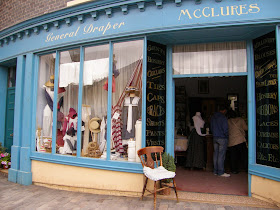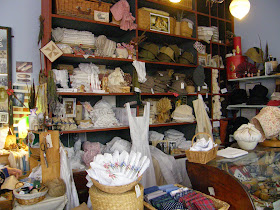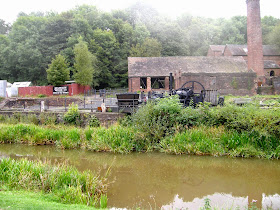On Saturday morning we started our day at the Museum of the Gorge which has a wonderful 40ft long scale model of the Ironbridge Gorge as it was in 1796. It is worth going in for this alone. The detail is incredible and I could have spent much longer looking at it. Impossible to photograph though so the photo above is of the gorge in real life with the River Severn flowing down towards the Bristol Channel. At 220 miles the Severn is the longest river in the UK.
After looking round the Museum of the Gorge we had a little walk round the town of Ironbridge. I crossed the bridge and was standing on the south side of the river to take this photo, on the left is the old Toll House and on the other side you can see St Luke's church.
This is the table of tolls that people had to pay to cross the bridge, it's very faded at the bottom but if you enlarge it you'll be able to read the charge for foot passengers which is a halfpenny. Any workman who lived on the south side of the river would have to pay this charge every day just to get to work and 3d a week out of the pittance they earned would have maybe made a difference to whether or not the family could buy food at the end of the week.
On a quick walk along the towpath I spotted what appears to be a pirate ship sailing under the bridge!
The rest of the day was spent at Blists Hill. This is a reconstructed Victorian Town but also has industrial exhibits - some of the buildings are original as it was built on a former industrial site which had a brick and tile works, blast furnaces and coal, iron and fire clay mines. Above is the grocers shop which was fascinating inside and contained a great many things that I remember well even though I don't
quite go back to the Victorian era:)
I love the old scales and the ceramic jars filled with dried fruits and nuts. They had the old blue bags that sugar used to be weighed out and packed in too.
This is the chemists shop which was used in the television series 'The Victorian Pharmacy'.
The inside was just amazing - the pharmacist would prepare many of his own medicines as well as selling patent medicines. He catered for animals as well as people and was often the local dentist as well! As today various beauty creams and lotions would be available too. Both these photos are worth enlarging to see the detail.
The drapers shop sold both ready made clothes and all kinds of haberdashery. I love the purple parasol!
This is part of the Shropshire Canal with some of the original industrial buildings on the far bank - I think that this may be the brick and tile works, if I'm right then this is where the last itinerant
master brickmaker works and the bricks are still handmade.
More of the industrial heritage, here we have the pithead of a coal mine with the winding gear at the back.
One of the beautiful Shire horses who work at Blists Hill.
Naturally we had to go in the lift that goes from the canal level to the lower part of the town:)
The Squatters Cottage - my favourite thing at Blists Hill! It dates from the 1840s and is a tiny two room cottage originally lived in by a collier, his wife and seven children! It was rescued from Burrough's Bank near Telford and re-erected at Blists Hill. It wasn't illegal or built within 24 hours but was built by the cottager of local stone and tree trunks on the property of the landowner. This saved the landowner from having to provide accommodation for his workers. The occupants paid an annual 'fine' or rent and if they carried on paying for three generations the cottage became theirs. This one was lived in until the 1970s.
The old tin bath hanging on the wall outside. The cottage had a garden for growing herbs and vegetables and there was a pigsty too. Almost certainly they would have had a few hens as well as the pig.
The bedroom had a bed for the parents and one that would have held a couple of children head to tail. Heaven knows where the others slept! On straw pallets on the floor at a guess. There were no wardrobes or chests of drawers, storage was in boxes,baskets and nails on the wall. Not that they would have had very much to store.
My gran brought up nine children in a two up two down terrace house though the age range meant that they were never all living there at once. I know that there was a curtain hung down the middle of the room with boys on one side and girls on the other and they definitely slept head to tail in the beds.
The cottage smelt wonderful when we went in, the lady who did the living history had cooked a joint of beef on the range - not something that will have happened very often in reality I suspect.
This is the old range - it was a cosy little room and efforts had been made to make it look nice, a few flowers in an old jug, newspaper cut into paper frills to edge the shelves and I like to think that in winter there would have been a rag rug on those tiles. My gran certainly had one in front of her range when I was a little girl.
There was so much more to see as well, definitely enough for a full day out and for all ages - there was a Victorian fairground for the children as well as a schoolroom, an old fashioned sweet shop where you could actually buy sweets - and I did! I shall try and do another short post about what we saw on Sunday but as my daughter and I are off to Madrid on Saturday I may not have time. We shall see!




















































